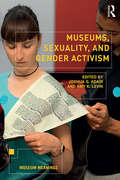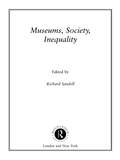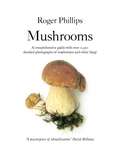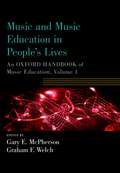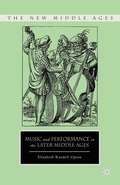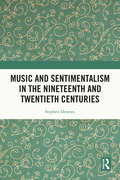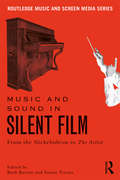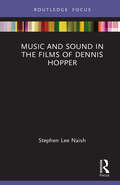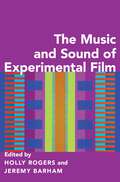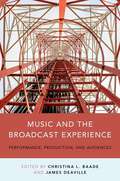- Table View
- List View
Museums of Language and the Display of Intangible Cultural Heritage (Routledge Research in Museum Studies)
by Nadia Cannata Maia Wellington Gahtan Margaret J. M. SönmezMuseums of Language and the Display of Intangible Cultural Heritage presents essays by practitioners based in language museums around the world. Describing their history, mission, and modes of display, contributors demonstrate the important role intangible heritage can and should play in the museum. Arguing that languages are among our most precious forms of cultural heritage, the book also demonstrates that they are at risk of neglect, and of endangerment from globalisation and linguistic imperialism. Including case studies from across Europe, North America, Africa, and Asia, this book documents the vital work being done by museums to help preserve languages and make them objects of broad public interest. Divided into three sections, contributions to the book focus on one of three types of museums: museums of individual languages, museums of language groups – both geographic and structural – and museums of writing. The volume presents practical information alongside theoretical discussions and state-of-the-art commentaries concerning the representation of languages and their cultural nature. Museums of Language and the Display of Intangible Cultural Heritage is the first volume to address the subject of language museums and, as such, should be of interest to academics, researchers, and postgraduate students in the fields of museum and cultural heritage studies, applied linguistics, anthropology, tourism, and public education.
Museums of Language and the Display of Intangible Cultural Heritage (Routledge Research in Museum Studies)
by Margaret J.-M. Sönmez Maia Wellington Gahtan Nadia CannataMuseums of Language and the Display of Intangible Cultural Heritage presents essays by practitioners based in language museums around the world. Describing their history, mission, and modes of display, contributors demonstrate the important role intangible heritage can and should play in the museum. Arguing that languages are among our most precious forms of cultural heritage, the book also demonstrates that they are at risk of neglect, and of endangerment from globalisation and linguistic imperialism. Including case studies from across Europe, North America, Africa, and Asia, this book documents the vital work being done by museums to help preserve languages and make them objects of broad public interest. Divided into three sections, contributions to the book focus on one of three types of museums: museums of individual languages, museums of language groups – both geographic and structural – and museums of writing. The volume presents practical information alongside theoretical discussions and state-of-the-art commentaries concerning the representation of languages and their cultural nature. Museums of Language and the Display of Intangible Cultural Heritage is the first volume to address the subject of language museums and, as such, should be of interest to academics, researchers, and postgraduate students in the fields of museum and cultural heritage studies, applied linguistics, anthropology, tourism, and public education.
Museums, Refugees and Communities (Routledge Research in Museum Studies)
by Domenico SergiMuseums, Refugees and Communities explores the ways in which museums in Germany, The Netherlands and the UK have responded to the complexities and ethical dilemmas involved in discussing the reasons for, and issues surrounding, contemporary refugee displacements. Building upon an ethnographic study carried out in the UK with refugees from the Democratic Republic of Congo, the book explores how object-led approaches can inspire new ways of thinking about and analysing refugees’ experiences and European museums’ work with their communities. Enlarging the developing body of research on museums’ increasing engagement with human rights and focusing in particular on the social, cultural and practical dimensions of community engagement practices with refugees, the book also aims to inform growing debates on museums as sites of activism. Museums, Refugees and Communities offers an innovative and interdisciplinary examination of museum work with and about refugees. As such, it should appeal to researchers, academics and students engaged in the study of museums, heritage, migration, ethics, community engagement, culture, sociology and anthropology.
Museums, Refugees and Communities (Routledge Research in Museum Studies)
by Domenico SergiMuseums, Refugees and Communities explores the ways in which museums in Germany, The Netherlands and the UK have responded to the complexities and ethical dilemmas involved in discussing the reasons for, and issues surrounding, contemporary refugee displacements. Building upon an ethnographic study carried out in the UK with refugees from the Democratic Republic of Congo, the book explores how object-led approaches can inspire new ways of thinking about and analysing refugees’ experiences and European museums’ work with their communities. Enlarging the developing body of research on museums’ increasing engagement with human rights and focusing in particular on the social, cultural and practical dimensions of community engagement practices with refugees, the book also aims to inform growing debates on museums as sites of activism. Museums, Refugees and Communities offers an innovative and interdisciplinary examination of museum work with and about refugees. As such, it should appeal to researchers, academics and students engaged in the study of museums, heritage, migration, ethics, community engagement, culture, sociology and anthropology.
Museums, Sexuality, and Gender Activism (Museum Meanings)
by Joshua G. Adair Amy K. LevinMuseums, Sexuality, and Gender Activism examines the role of exhibitionary institutions in representing LGBTQ+ people, cisgender women, and nonbinary individuals. Considering recent gender and sexuality-related developments through a critical lens, the volume contributes significantly to the growing body of activist writing on this topic. Building on Gender, Sexuality and Museums and featuring work from established voices, as well as newcomers, this volume offers risky and exciting articles from around the world. Chapters cover diverse topics, including transgender representation, erasure, and activism; two-spirit people, indigeneity, and museums; third genders; gender and sexuality in heritage sites and historic homes; temporary exhibitions on gender and sexuality; museum representations of HIV/AIDS; interventions to increase queer visibility and inclusion in galleries; LGBTQ+ staff alliances; and museums, gender ambiguity, and the disruption of binaries. Several chapters focus on areas outside the US and Europe, while others explore central topics through the perspectives of racial and ethnic minorities. Containing contributions that engage in sustained critique of current policies, theory, and practice, Museums, Sexuality, and Gender Activism is essential reading for those studying museums, women and gender, sexuality, culture, history, heritage, art, media, and anthropology. The book will also spark interest among museum practitioners, public archivists, and scholars researching related topics.
Museums, Sexuality, and Gender Activism (Museum Meanings)
by Joshua G. Adair Amy K. LevinMuseums, Sexuality, and Gender Activism examines the role of exhibitionary institutions in representing LGBTQ+ people, cisgender women, and nonbinary individuals. Considering recent gender and sexuality-related developments through a critical lens, the volume contributes significantly to the growing body of activist writing on this topic. Building on Gender, Sexuality and Museums and featuring work from established voices, as well as newcomers, this volume offers risky and exciting articles from around the world. Chapters cover diverse topics, including transgender representation, erasure, and activism; two-spirit people, indigeneity, and museums; third genders; gender and sexuality in heritage sites and historic homes; temporary exhibitions on gender and sexuality; museum representations of HIV/AIDS; interventions to increase queer visibility and inclusion in galleries; LGBTQ+ staff alliances; and museums, gender ambiguity, and the disruption of binaries. Several chapters focus on areas outside the US and Europe, while others explore central topics through the perspectives of racial and ethnic minorities. Containing contributions that engage in sustained critique of current policies, theory, and practice, Museums, Sexuality, and Gender Activism is essential reading for those studying museums, women and gender, sexuality, culture, history, heritage, art, media, and anthropology. The book will also spark interest among museum practitioners, public archivists, and scholars researching related topics.
Museums, Societies and the Creation of Value (Routledge Research in Museum Studies)
by Howard Morphy Robyn McKenzieMuseums, Societies and the Creation of Value focuses on the ways in which museums and the use of their collections have contributed to, and continue to be engaged with, value creation processes. Including chapters from many of the leading figures in museum anthropology, as well as from outstanding early-career researchers, this volume presents a diverse range of international case studies that bridge the gap between theory and practice. It demonstrates that ethnographic collections and the museums that hold and curate them have played a central role in the value creation processes that have changed attitudes to cultural differences. The essays engage richly with many of the important issues of contemporary museum discourse and practice. They show how collections exist at the ever-changing point of articulation between the source communities and the people and cultures of the museum and challenge presentist critiques of museums that position them as locked into the time that they emerged. Museums, Societies and the Creation of Value provides examples of the productive outcomes of collaborative work and relationships, showing how they can be mutually beneficial. The book will be of great interest to researchers and students engaged in the study of museums and heritage, anthropology, culture, Indigenous peoples, postcolonialism, history and sociology. It will also be of interest to museum professionals.
Museums, Societies and the Creation of Value (Routledge Research in Museum Studies)
by Howard Morphy Robyn McKenzieMuseums, Societies and the Creation of Value focuses on the ways in which museums and the use of their collections have contributed to, and continue to be engaged with, value creation processes. Including chapters from many of the leading figures in museum anthropology, as well as from outstanding early-career researchers, this volume presents a diverse range of international case studies that bridge the gap between theory and practice. It demonstrates that ethnographic collections and the museums that hold and curate them have played a central role in the value creation processes that have changed attitudes to cultural differences. The essays engage richly with many of the important issues of contemporary museum discourse and practice. They show how collections exist at the ever-changing point of articulation between the source communities and the people and cultures of the museum and challenge presentist critiques of museums that position them as locked into the time that they emerged. Museums, Societies and the Creation of Value provides examples of the productive outcomes of collaborative work and relationships, showing how they can be mutually beneficial. The book will be of great interest to researchers and students engaged in the study of museums and heritage, anthropology, culture, Indigenous peoples, postcolonialism, history and sociology. It will also be of interest to museum professionals.
Museums, Society, Inequality (Museum Meanings)
by Richard SandellMuseums, Society, Inequality explores the wide-ranging social roles and responsibilities of the museum. It brings together international perspectives to stimulate critical debate, inform the work of practitioners and policy makers, and to advance recognition of the purpose, responsibilities and value to society of museums. Museums, Society, Inequality examines the issues and: offers different understandings of the social agency of the museum presents ways in which museums have sought to engage with social concerns, and instigate social change imagines how museums might become more useful to society in future. This book is essential for all museum academics, practitioners and students.
Museums, Society, Inequality (Museum Meanings)
by Richard SandellMuseums, Society, Inequality explores the wide-ranging social roles and responsibilities of the museum. It brings together international perspectives to stimulate critical debate, inform the work of practitioners and policy makers, and to advance recognition of the purpose, responsibilities and value to society of museums. Museums, Society, Inequality examines the issues and: offers different understandings of the social agency of the museum presents ways in which museums have sought to engage with social concerns, and instigate social change imagines how museums might become more useful to society in future. This book is essential for all museum academics, practitioners and students.
Museums, the Media and Refugees: Stories of Crisis, Control and Compassion (Museums and Diversity #3)
by Katherine Goodnow Jack Lohman Philip MarfleetAcross countries and time, asylum-seekers and refugees have been represented in a variety of ways. In some representations they appear negatively, as dangers threatening to ‘over-run’ a country or a region with ‘floods’ of incompatible strangers. In others, the same people are portrayed positively, with compassion, and pictured as desperately in need of assistance. How these competing perceptions are received has significant consequences for determining public policy, human rights, international agreements, and the realization of cultural diversity, and so it is imperative to understand how these images are perpetuated. To this end, this volume reflects on museum practice and the contexts, stories, and images of asylum seekers and refugees prevalent in our mass media. Based on case studies from Australia, New Zealand, and the United Kingdom, the overall findings are illustrative of narratives and images common to museums and the media throughout the world. They aim to challenge political rhetoric and populist media imagery and consider what forms of dissent are likely to be sustained and what narratives ultimately break through and can lead to empathy and positive political change.
Museums, Transculturality, and the Nation-State: Case Studies from a Global Context (Edition Museum #52)
by Susanne Leeb Nina SamuelWhile the nation-state gave rise to the advent of museums, its influence in times of transculturality and post-/decolonial studies appears to have vanished. But is this really the case? With case studies from various geo- and sociopolitical contexts from around the globe, the contributors investigate which roles the nation-state continues to play in museums, collections, and heritage. They answer the question to which degree the nation-state still determines practices of collection and circulation and its amount of power to shape contemporary narratives. The volume thus examines the contradictions at play when the necessary claim for transculturality meets the institutions of the nation-state. With contributions by Stanislas Spero Adotevi, Sebastián Eduardo Dávila, Natasha Ginwala, Monica Hanna, Rajkamal Kahlon, Suzana Milevska, Mirjam Shatanawi, Kavita Singh, Ruth Stamm, Andrea Witcomb.
Mush and Me (Oberon Modern Plays)
by Karla Crome‘He had two sons. Isaac and Ishmael. And Ishmael branched out a bit. He went to live in the desert, got married, had children. Then, a few hundred years later, the prophet is born and boom. It’s Islam. So me and you are actually related.’ A Jew and a Muslim walk into a bar… People talk. Rumours spread. In Wetherspoons and hotel rooms, two young believers are reluctantly falling in love. Cultural pressures and contemporary life collide in this funny and heart-warming new play by Karla Crome. A story about faith, family and bacon butties. Winner of the IdeasTap Underbelly Edinburgh Award and Holden Street Adelaide Fringe Award.
Mushrooms: A comprehensive guide to mushroom identification (A\pan Original Ser.)
by Roger Phillips'Roger Phillips has written the best mushroom book I know.' Hugh Fearnley-WhittingstallThe culmination of over thirty years' work, Roger Phillips's authoritative and superbly illustrated reference work is packed with the most up-to-date information and original photographs. The essential illustrated mycological encyclopedia, this book is also clear, user friendly and will appeal to a wide range of readers. Unsurpassed in both illustrative and descriptive detail, Mushrooms contains over 1,250 photographs, often showing the specimens in various stages of growth, and includes all the latest botanical and common names as well as current ecological information on endangered species. Having sold more than 750,000 copies in Europe of his previous title on mushrooms, Roger Phillips's Mushrooms once again sets the benchmark. Quite simply, nobody with an interest in the subject can afford to be without this book.
Music and Diplomacy from the Early Modern Era to the Present
by Rebekah Ahrendt Mark Ferraguto Damien MahietHow does music shape the exercise of diplomacy, the pursuit of power, and the conduct of international relations? Drawing together international scholars with backgrounds in musicology, ethnomusicology, political science, cultural history, and communication, this volume interweaves historical, theoretical, and practical perspectives.
Music and Music Education in People's Lives: An Oxford Handbook of Music Education, Volume 1 (Oxford Handbooks)
by Gary E. McPherson and Graham F. WelchMusic and Music Education in People's Lives is one of five paperback books derived from the foundational two-volume Oxford Handbook of Music Education. Designed for music teachers, students, and scholars of music education, as well as educational administrators and policy makers, this first book in the set provides a framework for understanding the content and context of music education, and for future action within the profession. A broad examination of the philosophical, psychological, cultural, international, and contextual issues that underpin a wide variety of teaching environments or individual attributes is paired with 25 relevant and insightful commentaries from established scholars and music educators. Taken as a whole, Music and Music Education in People's Lives gives clear direction to how the discipline of music education can achieve even greater political, theoretical and professional strength. Contributors Harold F. Abeles, Nick Beach, Wayne D. Bowman, Liora Bresler, Patricia Shehan Campbell, Richard Colwell, Robert A. Cutietta, David J. Elliott, Sergio Figueiredo, Lucy Green, Wilfried Gruhn, David Hargreaves, Sarah Hennessy, Liane Hentschke, Donald A. Hodges, Christopher M. Johnson, Estelle R. Jorgensen, Andreas C. Lehmann, Richard Letts, Håkan Lundström, Raymond MacDonald, Clifford K. Madsen, Andrew J. Martin, Marie McCarthy, Katrina McFerran, Gary E. McPherson, Bradley Merrick, Dorothy Miell, Graça Mota, Bruno Nettl, Bengt Olsson, Susan A. O'Neill, Johnmarshall Reeve, Bennett Reimer, James Renwick, Huib Schippers, Wendy L. Sims, David J. Teachout, Rena Upitis, Peter R. Webster, Graham F. Welch, Paul Woodford
Music and Music Education in People's Lives: An Oxford Handbook of Music Education, Volume 1 (Oxford Handbooks)
Music and Music Education in People's Lives is one of five paperback books derived from the foundational two-volume Oxford Handbook of Music Education. Designed for music teachers, students, and scholars of music education, as well as educational administrators and policy makers, this first book in the set provides a framework for understanding the content and context of music education, and for future action within the profession. A broad examination of the philosophical, psychological, cultural, international, and contextual issues that underpin a wide variety of teaching environments or individual attributes is paired with 25 relevant and insightful commentaries from established scholars and music educators. Taken as a whole, Music and Music Education in People's Lives gives clear direction to how the discipline of music education can achieve even greater political, theoretical and professional strength. Contributors Harold F. Abeles, Nick Beach, Wayne D. Bowman, Liora Bresler, Patricia Shehan Campbell, Richard Colwell, Robert A. Cutietta, David J. Elliott, Sergio Figueiredo, Lucy Green, Wilfried Gruhn, David Hargreaves, Sarah Hennessy, Liane Hentschke, Donald A. Hodges, Christopher M. Johnson, Estelle R. Jorgensen, Andreas C. Lehmann, Richard Letts, Håkan Lundström, Raymond MacDonald, Clifford K. Madsen, Andrew J. Martin, Marie McCarthy, Katrina McFerran, Gary E. McPherson, Bradley Merrick, Dorothy Miell, Graça Mota, Bruno Nettl, Bengt Olsson, Susan A. O'Neill, Johnmarshall Reeve, Bennett Reimer, James Renwick, Huib Schippers, Wendy L. Sims, David J. Teachout, Rena Upitis, Peter R. Webster, Graham F. Welch, Paul Woodford
Music and Performance in the Later Middle Ages (The New Middle Ages)
by E. UptonThis book seeks to understand the music of the later Middle Ages in a fuller perspective, moving beyond the traditional focus on the creative work of composers in isolation to consider the participation of performers and listeners in music-making.
Music and Sentimentalism in the Nineteenth and Twentieth Centuries
by Stephen DownesIn a wide-ranging study of sentimentalism’s significance for styles, practices and meanings of music in the nineteenth and twentieth centuries, a series of interpretations scrutinizes musical expressions of sympathetic responses to suffering and the longing to belong. The book challenges hierarchies of artistic value and the associated denigration of sentimental feeling in gendered discourses. Fresh insights are thereby developed into sentimentalism’s place in musical constructions of emotion, taste, genre, gender, desire, and authenticity. The contexts encompass diverse musical communities, performing spaces, and listening practices, including the nineteenth-century salon and concert hall, the cinema, the intimate stage persona of the singer-songwriter, and the homely ambiguities of ‘easy’ listening. Interdisciplinary insights inform discussions of musical form, affect, appropriation, nationalisms, psychologies, eco-sentimentalism, humanitarianism, consumerism, and subject positions, with a particular emphasis on masculine sentimentalities. Music is drawn from violin repertory associated with Joseph Joachim, the piano music of Chopin, Schumann, and Liszt, sentimental waltzes from Schubert to Ravel, concert music by Bartók, Szymanowski and Górecki, the Merchant-Ivory adaptation of The Remains of the Day, Antônio Carlos Jobim’s bossa nova, and songs by Duke Ellington, Burt Bacharach, Carole King, Barry Manilow and Jimmy Webb. The book will attract readers interested in both the role of music in the history of emotion and the persistence and diversity of sentimental arts after their flowering in the eighteenth-century age of sensibility.
Music and Sentimentalism in the Nineteenth and Twentieth Centuries
by Stephen DownesIn a wide-ranging study of sentimentalism’s significance for styles, practices and meanings of music in the nineteenth and twentieth centuries, a series of interpretations scrutinizes musical expressions of sympathetic responses to suffering and the longing to belong. The book challenges hierarchies of artistic value and the associated denigration of sentimental feeling in gendered discourses. Fresh insights are thereby developed into sentimentalism’s place in musical constructions of emotion, taste, genre, gender, desire, and authenticity. The contexts encompass diverse musical communities, performing spaces, and listening practices, including the nineteenth-century salon and concert hall, the cinema, the intimate stage persona of the singer-songwriter, and the homely ambiguities of ‘easy’ listening. Interdisciplinary insights inform discussions of musical form, affect, appropriation, nationalisms, psychologies, eco-sentimentalism, humanitarianism, consumerism, and subject positions, with a particular emphasis on masculine sentimentalities. Music is drawn from violin repertory associated with Joseph Joachim, the piano music of Chopin, Schumann, and Liszt, sentimental waltzes from Schubert to Ravel, concert music by Bartók, Szymanowski and Górecki, the Merchant-Ivory adaptation of The Remains of the Day, Antônio Carlos Jobim’s bossa nova, and songs by Duke Ellington, Burt Bacharach, Carole King, Barry Manilow and Jimmy Webb. The book will attract readers interested in both the role of music in the history of emotion and the persistence and diversity of sentimental arts after their flowering in the eighteenth-century age of sensibility.
Music and Sound in Silent Film: From the Nickelodeon to The Artist
by Ruth Barton Simon TreziseDespite their name, the silent films of the early cinematic era were frequently accompanied by music and other sound elements of many kinds, including mechanical instruments, live performers, and audience sing-alongs. The 12 chapters in this concise book explore the multitude of functions filled by music in the rapidly changing context of the silent film era, as the concept of cinema itself developed. Examples are drawn from around the globe and across the history of silent film, both during the classic era of silent film and later uses of the silent format. With contributors drawn from film studies and music disciplines, and including both senior and emerging scholars, Music and Sound in Silent Film offers an essential introduction to the origins of film music and the cinematic art form.
Music and Sound in the Films of Dennis Hopper (Filmmakers and Their Soundtracks)
by Stephen Lee NaishAcross his directorial films, American filmmaker Dennis Hopper used music and sound to propel the narrative, signpost the era in which the films were made, and delineate the characters’ place within American culture. This book explores five of Hopper’s films to show how this deep engagement with music to build character and setting continued throughout his career, as Hopper used folk, punk, hip-hop, and jazz to shape the worlds of his films in ways that influenced other filmmakers and foreshadowed the advent of the music video format.The author traces Hopper’s distinctive approach to the use of music through films from 1969 to 1990, including his innovative use of popular rock, pop, and folk in Easy Rider, his blending of diegetic performances of folk and Peruvian indigenous music in The Last Movie, his use of punk rock in Out of the Blue, incorporation of hip-hop and rap in Colors, and commissioning of a jazz/blues soundtrack by Miles Davis and John Lee Hooker for The Hot Spot. Uncovering the film soundtrack as a vital piece of the narrative, this concise and accessible book offers insights for academic readers in music and film studies, as well as all those interested in Hopper’s work.
Music and Sound in the Films of Dennis Hopper (Filmmakers and Their Soundtracks)
by Stephen Lee NaishAcross his directorial films, American filmmaker Dennis Hopper used music and sound to propel the narrative, signpost the era in which the films were made, and delineate the characters’ place within American culture. This book explores five of Hopper’s films to show how this deep engagement with music to build character and setting continued throughout his career, as Hopper used folk, punk, hip-hop, and jazz to shape the worlds of his films in ways that influenced other filmmakers and foreshadowed the advent of the music video format.The author traces Hopper’s distinctive approach to the use of music through films from 1969 to 1990, including his innovative use of popular rock, pop, and folk in Easy Rider, his blending of diegetic performances of folk and Peruvian indigenous music in The Last Movie, his use of punk rock in Out of the Blue, incorporation of hip-hop and rap in Colors, and commissioning of a jazz/blues soundtrack by Miles Davis and John Lee Hooker for The Hot Spot. Uncovering the film soundtrack as a vital piece of the narrative, this concise and accessible book offers insights for academic readers in music and film studies, as well as all those interested in Hopper’s work.
The Music and Sound of Experimental Film
This book explores music/sound-image relationships in non-mainstream screen repertoire from the earliest examples of experimental audiovisuality to the most recent forms of expanded and digital technology. It challenges presumptions of visual primacy in experimental cinema and rethinks screen music discourse in light of the aesthetics of non-commercial imperatives. Several themes run through the book, connecting with and significantly enlarging upon current critical discourse surrounding realism and audibility in the fiction film, the role of music in mainstream cinema, and the audiovisual strategies of experimental film. The contributors investigate repertoires and artists from Europe and the USA through the critical lenses of synchronicity and animated sound, interrelations of experimentation in image and sound, audiovisual synchresis and dissonance, experimental soundscape traditions, found-footage film, re-mediation of pre-existent music and sound, popular and queer sound cultures, and a diversity of radical technological, aesthetic, tropes in film media traversing the work of early pioneers such as Walther Ruttmann and Len Lye, through the mid-century innovations of Norman McLaren, Stan Brakhage, Lis Rhodes, Kenneth Anger, Andy Warhol, and studio collectives in Poland, to latter-day experimentalists John Smith and Bill Morrison, as well as the contemporary practices of Vjing.
Music and the Broadcast Experience: Performance, Production, and Audiences
Music and the Broadcast Experience explores the complex ways in which music and broadcasting have developed together throughout the twentieth and into the twenty-first centuries. It brings into dialogue researchers working in media and music studies; explores and develops crucial points of contact between studies of music in radio and music in television; and investigates the limits, persistence, and extensions of music broadcasting in the Internet era. The book presents a series of case studies that address key moments and concerns in music broadcasting, past and present, written by leading scholars in the field, who hail from both media and music studies. Unified by attentiveness both to musical sound and meaning and to broadcasting structures, practices, audiences, and discourses, the chapters in this collection address the following topics: the role of live orchestral concerts and opera in the early development of radio and their relation to ideologies of musical uplift; the relation between production culture, music, and television genre; the function of music in sponsored radio during the 1930s; the fortunes of musical celebrity and artistic ambition on television; questions of music format and political economy in the development of online radio; and the negotiation of space, community, and participation among audiences, online and offline, in the early twenty-first century. The collection's ultimate aim is to explore the usefulness and limitations of broadcasting as a concept for understanding music and its cultural role, both historically and today.


